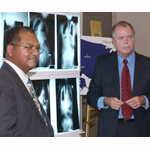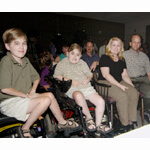

San Antonio (Sept. 13, 2004) – The Vertical Expandable Prosthetic Titanium Rib (VEPTR), a device that has saved the lives of 300 infants and young children who otherwise would have died from lack of breath, has been approved by the U.S. Food and Drug Administration (FDA). The inventor from The University of Texas Health Science Center at San Antonio and the Thoracic Institute at CHRISTUS Santa Rosa Children’s Hospital said it is the first new growth-sparing spine deformity treatment to gain FDA approval in more than four decades.
“We have described a new disease and have named it thoracic insufficiency syndrome,” said Robert M. Campbell Jr., M.D., professor of orthopedics at the Health Science Center, director of the Thoracic Institute at CHRISTUS Santa Rosa and inventor of the titanium rib. “It describes a group of patients who have scoliosis, may have fused ribs or a small chest, and this causes harm to respiration and lung growth. Characterizing the disease is more important than the titanium rib itself, because children with these conditions can be diagnosed more clearly using the thoracic insufficiency syndrome approach. We expect more sophisticated and better surgical solutions to be developed in the future.”
The work began in 1987 with the encouragement of Melvin D. Smith, M.D., staff physician at the Thoracic Institute and professor of pediatric general surgery at the Health Science Center. Dr. Smith went to Dr. Campbell with X-rays of infant Christopher Cardenas, who was born without a chest wall. The only option to save Christopher was to create an artificial chest wall, which the doctors were able to accomplish. Two years later, Dr. Campbell, who began college as an engineering student, developed the titanium rib and the surgeons were ready to implant it in a child – 2-year-old Christopher Cardenas. The operation was a success and Christopher, of San Antonio, now is 17.
The titanium rib is curved like a ribcage and has holes that allow the surgeons to expand the device in outpatient surgery every six months. The rib is implanted in infants as young as 6 months and in teenagers until skeletal maturity, typically age 14 in girls and age 16 in boys. “Our data suggest the earlier the better,” Dr. Campbell said. “The lung growth curve is best in the first two years of life.” The rib is made of titanium, a material that is lightweight, compatible with body tissues and does not interfere with MRI scans.
“We are starting to see several ‘Rib’ kids reach skeletal maturity,” Dr. Campbell added. “If the devices are performing their function and not causing a problem, we leave them in. It’s case by case, and there is not a global answer as to when to remove the device.”
As with any surgery, there is the potential for infection, but the surgeons have found the infection rate to be no different than for other types of surgeries. “There is a chance of devices drifting into the bone, and there can be skin problems over the rib if the kids do not have enough body weight, but we believe what it does to help the children outweighs the risks,” Dr. Campbell said.
Drs. Campbell and Smith have developed five new operations utilizing the titanium rib and have described thoracic insufficiency syndrome in four landmark papers in orthopedics journals. The surgeons have taught the titanium rib surgery techniques to other tertiary pediatric hospitals throughout the United States and all over the world. Last week, Drs. Campbell and Smith returned from a trip to a children’s hospital in Buenos Aires, Argentina. Last month, Dr. Campbell performed the surgery at Birmingham Children’s Hospital in England.
Dr. Campbell did the research in private practice for several years, but needed the support of an academic health science university for the project to proceed. He joined the Health Science Center faculty in 1992. “The Health Science Center has provided support for this research and helped make it happen,” Dr. Campbell said. “CHRISTUS Santa Rosa has been the site of all the titanium rib surgeries here in San Antonio.”
In the mid-1990s, Drs. Campbell and Smith, the Health Science Center and CHRISTUS Santa Rosa became coordinators of a multicenter FDA clinical trial to test the titanium rib. About 210 children have had the surgery at CHRISTUS Santa Rosa, and 90 at seven other children’s hospitals in Pittsburgh, Boston, Salt Lake City, Los Angeles, Seattle and Philadelphia.
“It took 13 years to gain FDA approval because it took a long time to accumulate a lot of patients with rare diseases,” Dr. Campbell said. “Also, the FDA examines very carefully any new spine treatment, especially one that is for children.”
The last major advance in spine treatment came along in 1962 – the Harrington Rod developed by Dr. Paul Harrington of Houston. The device revolutionized spine surgery, Dr. Campbell said.
For Frequently Asked Questions about the VEPTR visit:www.uthscsa.edu/HSCNews/archive/TitaniumRibFAQ.pdf
For the chronology of the Titanium Rib Project, visit:www.uthscsa.edu/HSCNews/archive/TitaniumRibChronology.pdf
For information about the Katka’s twins visit: www.uthscsa.edu/HSCNews/archive/TitaniumRibSidebar.pdf

